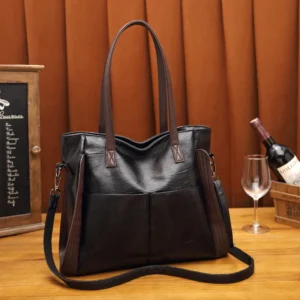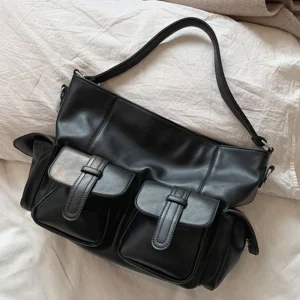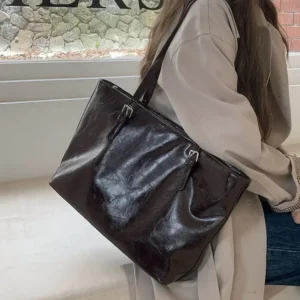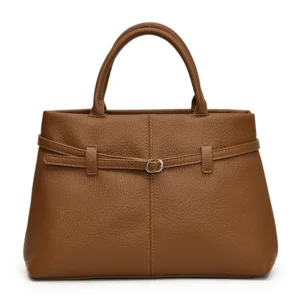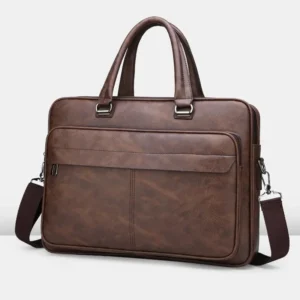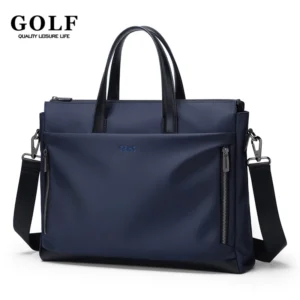Understanding Faux Leather Longevity
When shopping for a new bag, durability is often a top concern – especially when considering faux leather options. Many people wonder if vegan leather can truly stand the test of time, and the good news is that quality faux leather bags can indeed last for years with proper care and selection.
Faux leather (also called vegan leather, synthetic leather, or pleather) refers to materials designed to mimic the look and feel of animal leather without using animal products. While traditional perceptions might suggest limited durability, today’s reality is quite different:
- Average-quality faux leather bags typically last 2-5 years with regular use
- Premium faux leather options can remain in excellent condition for 5-10+ years
- Some innovative plant-based materials like cork leather can potentially last up to 20 years
The durability of faux leather matters not just for practical reasons but also represents an important intersection of ethics and economics. Consumers who choose vegan options for ethical reasons shouldn’t have to sacrifice longevity, especially when investing in professional accessories.
Recent advancements in manufacturing technology have significantly improved the durability of faux leather. Market research shows consumer demand for long-lasting vegan alternatives has increased by over 40% in recent years, pushing manufacturers to develop more resilient options. The difference between well-maintained and neglected faux leather can be dramatic – proper care can literally add years to your bag’s lifespan.
Understanding what makes timeless classic leather briefcases endure helps set realistic expectations for faux leather alternatives. While genuine leather has traditionally held the durability crown, the gap is narrowing as innovative materials continue to improve. When comparing faux leather versus real leather for daily use, the durability difference becomes less significant with proper care and quality selection.
Types of Faux Leather and Their Durability
Not all faux leather is created equal. The specific material used significantly impacts how long your bag will last. Let’s explore the most common types and their durability characteristics:
Traditional Synthetic Options
PU (Polyurethane) Leather
* Composition: Fabric backing with polyurethane coating
* Feel: Soft, flexible, most leather-like texture
* Durability: 2-5 years with proper care
* Common issues: Can crack over time, especially in cold conditions; susceptible to UV damage
PVC (Polyvinyl Chloride) Leather
* Composition: Plastic-based material with fabric backing
* Feel: Stiffer, less breathable than PU
* Durability: 3-8 years for quality versions
* Advantages: Excellent water resistance, highly resistant to stains, generally more durable than PU
Microfiber Synthetic Leather
* Composition: Ultra-fine fibers combined with resins
* Feel: Soft, supple, with excellent breathability
* Durability: 5-8+ years with proper care
* Advantages: Superior resistance to scratches and abrasion; maintains appearance longer
Innovative Plant-Based Options
Cork Leather
* Composition: Thin cork layers bonded to fabric backing
* Feel: Unique texture, lightweight, somewhat rigid initially but softens with use
* Durability: Exceptional longevity of 10-20+ years possible
* Advantages: Naturally water-resistant, doesn’t crack easily, develops beautiful patina
Cactus Leather (Desserto)
* Composition: Nopal cactus-derived materials with organic compounds
* Feel: Soft yet sturdy with distinctive texture
* Durability: Early testing suggests 5-8+ years
* Advantages: Excellent resistance to scratching, good water resistance
Pineapple Leather (Piñatex)
* Composition: Fibers from pineapple leaves
* Feel: Textured, somewhat stiff initially
* Durability: 3-5 years with proper care
* Advantages: Strengthens over initial breaking-in period
Apple Leather
* Composition: Apple industry waste combined with PU
* Feel: Soft, pliable, similar to traditional leather
* Durability: 3-5 years, continuing to improve as technology advances
* Advantages: Partially biodegradable compared to fully synthetic options
Our selection of vegan leather work totes showcases many of these innovative materials, offering durability along with style and function.
| Faux Leather Type | Durability Rating (1-10) | Typical Lifespan | Water Resistance | Sustainability Rating |
|---|---|---|---|---|
| PVC Leather | 7 | 3-8 years | Excellent | Low |
| PU Leather | 5 | 2-5 years | Good | Low-Medium |
| Microfiber | 8 | 5-8+ years | Good | Medium |
| Cork Leather | 9 | 10-20 years | Very Good | High |
| Cactus Leather | 7 | 5-8+ years | Good | High |
| Pineapple Leather | 6 | 3-5 years | Moderate | High |
| Apple Leather | 6 | 3-5 years | Good | Medium-High |
The science behind durability differences lies in molecular structure. PVC’s rigid polymer chains resist wear but make the material less flexible. PU offers better flexibility but its chemical bonds deteriorate faster with UV exposure. Plant-based materials like cork contain natural lignin and suberin compounds that provide remarkable resistance to wear and environmental damage.
When considering a professional bag investment, exploring various vegan leather briefcase options allows you to choose the material best suited for your specific needs and expected lifespan.
Key Factors That Determine Faux Leather Lifespan
The longevity of faux leather products depends on multiple factors beyond just the base material. Understanding these elements helps you make smarter purchasing decisions and manage expectations appropriately.
Material Quality Factors
- Thickness and density: Thicker faux leather (typically 1.0mm or greater) generally outlasts thinner versions, providing better resistance to wear and tear
- Quality of backing fabric: A strong, tightly woven backing significantly extends durability by preventing stretching and tearing
- Manufacturing techniques: Double-layered construction, heat-sealed edges, and properly applied finishes can dramatically improve longevity
Construction and Craftsmanship Elements
- Stitching quality:
- Look for tight, even stitching with no loose threads
- Reinforced double stitching at stress points indicates quality construction
- Nylon or polyester thread resists wear better than cotton
- Hardware quality:
- Solid metal hardware (brass, stainless steel) outlasts plated or plastic components
- Smooth-operating zippers with metal teeth typically last longer
- Properly installed rivets and reinforcements prevent tearing at attachment points
- Lining materials:
- Sturdy cotton canvas or synthetic linings resist tearing
- Properly attached linings prevent internal structure breakdown
- Reinforced interior pockets maintain shape over time
Usage Impact
- Daily use naturally accelerates wear compared to occasional use
- Overloading beyond designed capacity stresses seams and handles
- Rough handling, particularly frequent dropping or scraping, can damage even high-quality faux leather
- Consistent exposure to abrasive surfaces accelerates surface wear
Environmental Exposure
- UV degradation: Prolonged sun exposure causes faux leather to dry, crack, and fade
- Heat damage: Extreme temperatures (especially in cars during summer) can warp, melt, or degrade synthetic leather
- Moisture effects: While most faux leather resists water, prolonged exposure can damage backing materials and adhesives
- Chemical exposure: Alcohol-based products, oils, and harsh cleaning chemicals can break down the surface
Industry experts note that construction quality often matters more than the base material itself. A well-constructed bag made from mid-tier faux leather will often outlast a poorly constructed bag made from premium materials. This is why understanding how long faux leather bags last requires looking beyond just the material specification to these crucial quality indicators.
Essential Care for Maximum Longevity
Proper maintenance is perhaps the single most important factor in extending your faux leather bag’s lifespan. With the right care routine, even moderately priced options can provide years of reliable service.
Regular Cleaning Protocols
DO:
* Wipe down your bag weekly with a slightly damp, soft cloth
* Use mild soap (like unscented hand soap) diluted in water for deeper cleaning
* Test any cleaning product on an inconspicuous spot first
* Dry thoroughly with a soft cloth after cleaning
DON’T:
* Use alcohol-based cleaners, which can dry and crack faux leather
* Apply bleach or harsh detergents that can break down synthetic materials
* Scrub aggressively with abrasive materials
* Soak the bag or submerge it in water
For stubborn stains, try these specialized approaches:
* Ink: A small amount of isopropyl alcohol on a cotton swab (use sparingly and test first)
* Food stains: Mix mild soap with warm water, apply with soft cloth using gentle circular motions
* Oil marks: Cornstarch or talcum powder to absorb oil, then gentle cleaning
Conditioning Considerations
Unlike genuine leather, most faux leather doesn’t require regular conditioning, but occasional treatment can help maintain flexibility:
- Apply a specialized faux leather conditioner 2-3 times yearly
- Avoid leather conditioners made for real leather, as they can damage synthetic materials
- For plant-based leathers like cork, use specialized plant-based conditioners
Protection Strategies
- Apply a water and stain repellent designed specifically for synthetic leather
- Place items that could leak (makeup, pens) in separate pouches
- Avoid carrying sharp objects that might puncture or scratch
- Use a bag organizer to distribute weight evenly and maintain shape
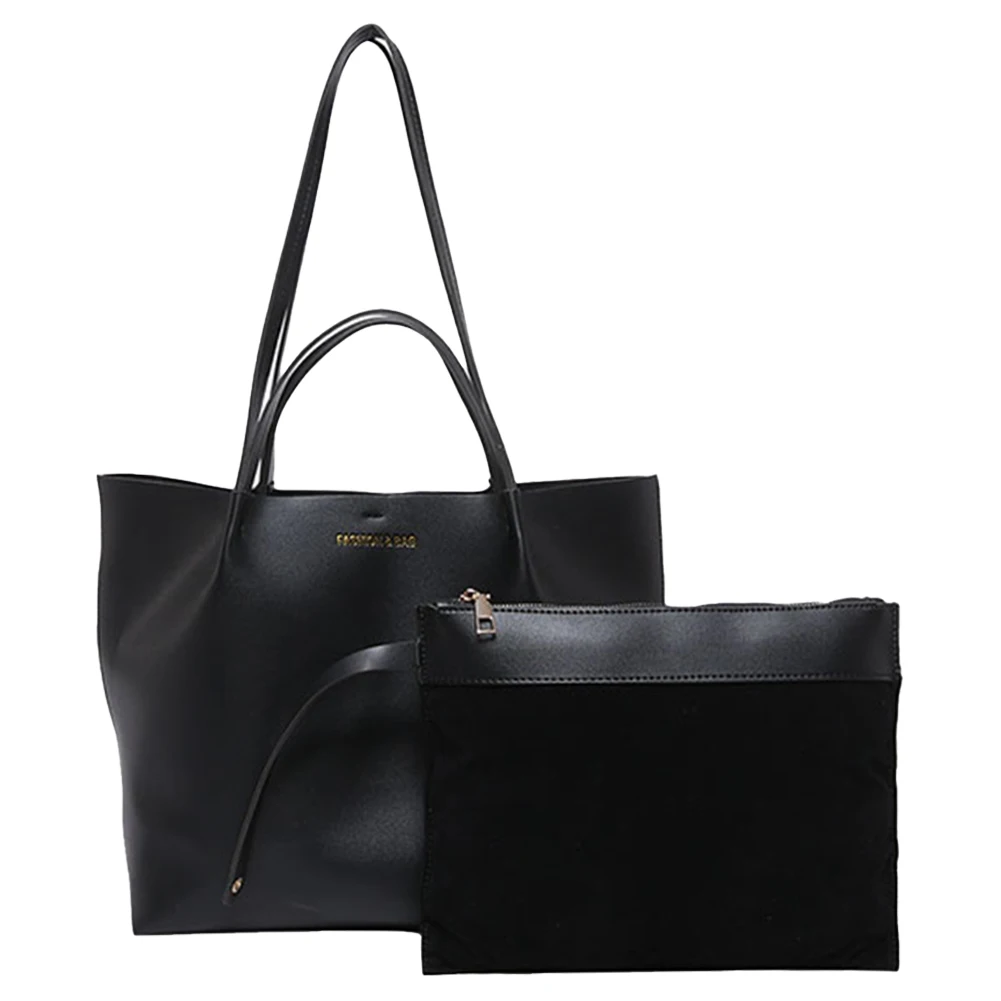
Proper Storage Techniques
- Store your bag in a dust bag when not in use
- Maintain shape by stuffing with acid-free tissue paper
- Place in a cool, dry location away from direct sunlight
- Store upright rather than hanging to prevent misshaping
- Never store in plastic bags, which can trap moisture and cause mildew
Addressing Common Issues
- Minor scuffs: Gently buff with a soft cloth
- Small scratches: Apply a tiny amount of petroleum jelly, let sit for 24 hours, then wipe away
- Preventing peeling: Apply UV protectant if the bag will be exposed to sunlight
- Water damage: Immediately dry with soft cloth, then allow to air dry completely before storing
Our comprehensive guide to faux leather bag care offers additional detailed techniques for maintaining specific types of vegan leather. With consistent care, even everyday use bags can maintain their appearance and structural integrity for years.
Faux vs. Genuine Leather: The Durability Comparison
When weighing options between faux and genuine leather, understanding the durability differences helps set realistic expectations and guides your purchasing decisions.
Lifespan Expectations
Genuine leather, particularly full-grain varieties, can last 10-30+ years with proper care. However, high-quality faux leather has narrowed this gap considerably:
- Premium PVC faux leather typically lasts 5-8 years
- Quality microfiber synthetic leather can remain serviceable for 5-10+ years
- Cork leather impressively approaches genuine leather’s longevity at 10-20+ years
The durability gap narrows further when comparing top-tier faux leather to lower-quality genuine leather (like corrected grain or bonded leather).
Maintenance Differences
| Aspect | Genuine Leather | Faux Leather |
|---|---|---|
| Regular conditioning | Required every 1-3 months | Minimal to none (material dependent) |
| Cleaning difficulty | Moderate (specific products needed) | Easy (simple soap and water often sufficient) |
| Water resistance | Poor to moderate (requires treatment) | Good to excellent (built-in) |
| Scratch resistance | Poor (scratches easily but develops patina) | Moderate to good (material dependent) |
| Stain resistance | Poor (absorbs liquids quickly) | Good (most liquids wipe off easily) |
Cost Implications
When evaluating long-term value, consider these factors:
- Initial investment: Quality faux leather bags typically cost 30-60% less than comparable genuine leather
- Longevity ratio: While genuine leather lasts longer, the price-to-durability ratio often favors faux leather
- Maintenance costs: Genuine leather requires specialized conditioners and protectants, adding to lifetime cost
A cost-per-wear analysis often reveals that mid-to-high-quality faux leather represents excellent value, particularly with proper care to maximize lifespan.
Ethical and Environmental Considerations
Beyond durability, many consumers consider other important factors:
- Animal welfare: Faux leather eliminates ethical concerns regarding animal treatment
- Traditional leather production involves significant water usage and chemical tanning processes
- PVC and PU faux leathers contain plastics that aren’t biodegradable
- Newer plant-based alternatives offer improved environmental profiles with competitive durability
For professionals seeking alternatives to animal products, our collection of non-leather work bags offers sustainable options without compromising professional appearance or functionality.
The gap between faux and durable leather bags for daily use continues to narrow as technology advances, making today’s high-quality vegan options increasingly competitive on longevity.
How to Identify Quality Faux Leather Bags
Knowing how to assess quality before purchasing is essential for finding faux leather bags that will last for years. These practical evaluation techniques help identify durable options worth your investment.
Visual and Tactile Quality Indicators
High Priority:
* Even, consistent coloring without patchy areas
* Smooth, unblemished surface free of bubbles or wrinkles
* Properly finished edges that don’t fray or show raw backing
* Appropriate weight and substance that suggests quality materials
Medium Priority:
* Flexibility without cracking or white stress marks
* Pleasant, non-chemical smell
* Backing material that appears tightly woven and secure
Construction Quality Signals
High Priority:
* Straight, even stitching with no loose threads or skipped stitches
* Double stitching at stress points (handles, straps, base corners)
* Reinforced hardware attachment points
Medium Priority:
* Lining properly attached without puckering or loose areas
* Smooth-operating zippers that don’t catch or bind
* Interior organizational features with quality stitching
Brand Research Strategies
- Read reviews focusing specifically on longevity and durability
- Look for warranties that suggest manufacturer confidence (1+ years)
- Research manufacturing processes and material sourcing
- Check if the brand emphasizes durability in their marketing (but verify through reviews)
Price as a Quality Indicator
While price alone doesn’t guarantee quality, extremely low prices often signal durability compromises:
- Budget faux leather bags ($20-50): Typically last 6-18 months with regular use
- Mid-range options ($50-150): Often provide 2-5 years of service with proper care
- Premium faux leather bags ($150-300+): Can last 5-10+ years when well-maintained
Red flags include prices significantly below market average for similar items, unclear material descriptions, or vague construction details.
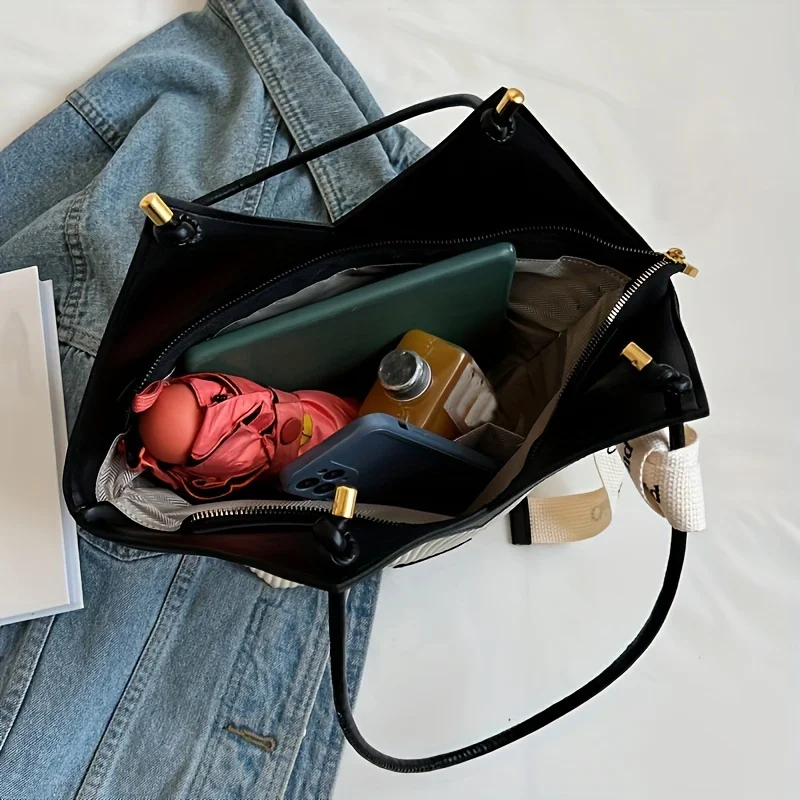
Top Brands Known for Durable Faux Leather Bags
When investing in a faux leather bag meant to last for years, certain brands consistently deliver superior durability through quality materials, excellent construction, and thoughtful design.
Selection Criteria
Our recommended brands meet stringent requirements:
* Consistent use of premium-grade faux leather materials
* Reinforced construction at stress points
* Positive long-term customer feedback regarding durability
* Commitment to innovation in materials and design
Leading Brands for Longevity
Matt & Nat
* Known for: Exceptional stitch quality and hardware durability
* Material focus: Premium PU with recycled nylon lining
* Customer evidence: Bags frequently reported lasting 5-8+ years
* Durability innovation: Unique water-resistant coating technology
Doshi
* Known for: Microfiber vegan leather with superior abrasion resistance
* Material focus: EPTT (Ethical Pro-Tech Textile) microfiber
* Customer evidence: Exceptional ratings for maintaining appearance after years of use
* Durability innovation: Advanced edge-finishing techniques that prevent peeling
Corkor
* Known for: Cork leather products with remarkable longevity
* Material focus: Premium Portuguese cork with fabric backing
* Customer evidence: Products maintaining structural integrity beyond 10 years
* Durability innovation: Specialized binding techniques for natural materials
Innovative Sustainable Brands
Desserto (Cactus Leather)
* Material innovation: Nopal cactus-based leather alternative
* Durability focus: Enhanced resistance to UV exposure and scratching
* Sustainability balance: Biodegradable while maintaining excellent wear characteristics
Piñatex
* Material innovation: Pineapple leaf fiber-based leather alternative
* Durability focus: Progressive strengthening during initial use period
* Sustainability balance: Uses agricultural waste while achieving competitive durability
Most Durable Faux Leather Bag Styles
Certain bag designs naturally enhance durability regardless of brand:
- Structured totes: The rigid design distributes weight evenly, reducing stress points
- Crossbody bags: Limited capacity prevents overloading and strain
- Briefcases with reinforced bases: Structured bottoms resist deformation and wear
Our faux leather work tote collection features many options specifically designed for professional durability.
Black Leather Satchel, Brown Leather Satchel, Vegan Leather Work Tote
Price range: $69.58 through $73.23 Select options This product has multiple variants. The options may be chosen on the product pageBlack Leather Messenger Bag, Black Leather Work Tote, Faux Leather Work Tote
$101.88 Select options This product has multiple variants. The options may be chosen on the product pageBlack Leather Work Tote, Faux Leather Work Tote, Women's Leather Business Tote
Price range: $88.81 through $93.85 Select options This product has multiple variants. The options may be chosen on the product pageBlack Leather Satchel, Faux Leather Work Tote, Vegan Leather Work Tote
$120.38 Select options This product has multiple variants. The options may be chosen on the product pageMen's Slim Leather Briefcase, Slim Leather Laptop Briefcase, Vegan Leather Briefcase
Price range: $120.82 through $131.11 Select options This product has multiple variants. The options may be chosen on the product pageClassic Laptop Briefcase, Vegan Leather Briefcase
$244.29 Select options This product has multiple variants. The options may be chosen on the product page
The Future of Durable Faux Leather
The landscape of vegan leather is rapidly evolving, with exciting developments promising even greater durability and sustainability in coming years.
Current Research and Development Trends
Material scientists are making significant breakthroughs that directly impact longevity:
* Bio-based polyurethanes derived from vegetable oils rather than fossil fuels
* Multi-layer construction techniques that combine the best properties of different materials
* Enhanced fiber reinforcement technologies that dramatically improve tear resistance
* Accelerated aging tests allowing manufacturers to predict and improve real-world durability
Manufacturing innovations are equally important:
* Precision automated stitching that creates stronger, more consistent seams
* Advanced edge finishing that prevents the backing from separating from the surface layer
* Heat-bonding techniques that eliminate potential failure points from traditional adhesives
Sustainability Innovations
The most exciting developments combine enhanced durability with environmental benefits:
* Fully biodegradable synthetic leathers that maintain structural integrity for 5+ years of use
* Circular economy approaches where bags can be returned for material recycling
* Bio-based materials that require significantly less energy to produce while matching or exceeding traditional faux leather durability
Market Evolution
Consumer preferences are driving industry changes:
* Growing demand for durability has elevated manufacturing standards across price points
* Competition in the high-quality vegan leather space is intensifying, benefiting consumers
* The price gap for premium durable options continues to narrow as manufacturing scales up
These advancements suggest that tomorrow’s faux leather bags will likely last even longer while reducing environmental impact – a win for both consumers and the planet.
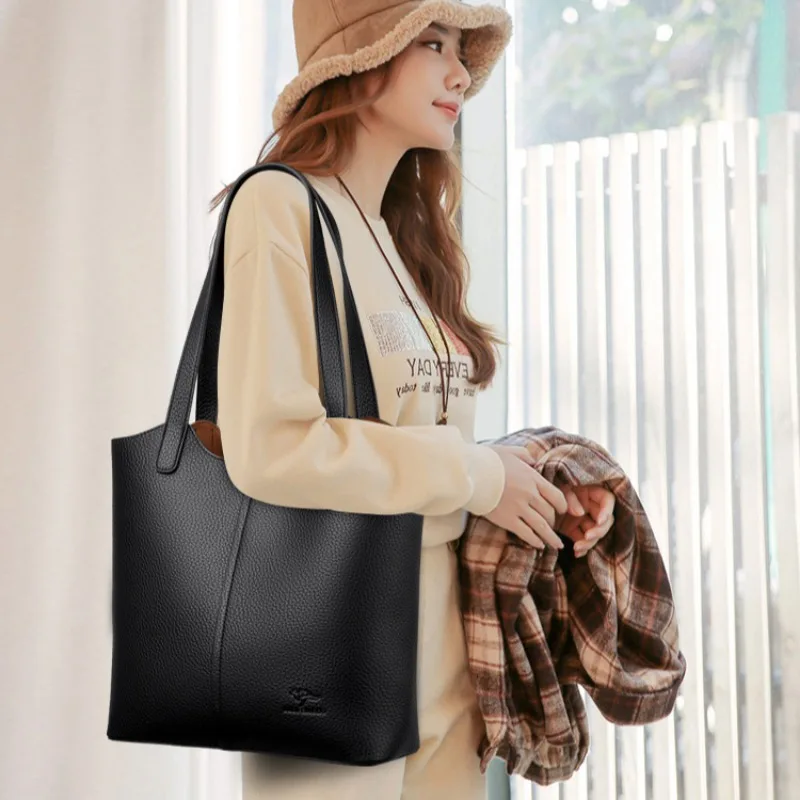
Frequently Asked Questions About Faux Leather Durability
How can I tell if a faux leather bag will be durable before buying?
Check the material thickness (aim for at least 1.0mm), examine the backing material for tight weaving, and inspect stitching quality. Quality faux leather should feel substantial, not thin or papery. Test flexibility by gently folding an inconspicuous area – it should bend without showing white stress marks or cracking.
What causes faux leather to peel, and how can I prevent it?
Peeling typically occurs when the polyurethane coating separates from the fabric backing due to UV exposure, heat damage, or physical stress. Prevent peeling by limiting sun exposure, using UV protectant sprays designed for synthetic materials, and avoiding overloading your bag.
Which lasts longer for daily use: PVC or PU faux leather?
For heavy daily use, PVC typically outlasts PU by 1-3 years. PVC’s more rigid molecular structure resists abrasion better, though it’s less environmentally friendly. For professional bags subjected to daily commuting, PVC or higher-quality microfiber synthetics generally provide superior longevity.
Can damaged faux leather be repaired effectively?
Minor damage like small scratches and scuffs can be improved using vinyl repair kits. Peeling areas can sometimes be stabilized with clear fabric glue. However, once faux leather begins significant peeling or cracking, comprehensive repair becomes difficult. Prevention remains the best strategy for longevity.
How do plant-based leathers like cork perform in real-world conditions?
Cork leather is surprisingly durable, with proper care often lasting 10-20 years. It naturally resists water, staining, and abrasion. Cactus and apple leathers are newer but showing promising 3-5 year durability in early testing. Plant-based options generally develop character with age rather than deteriorating like some synthetic options.
Do white or light-colored faux leather bags require special care?
Yes, light colors show stains and dirt more readily. Clean more frequently with mild soap and water, avoid contact with denim (which can transfer color), and apply protectant spray designed for synthetic leather. Consider products specifically formulated for light-colored synthetics to prevent yellowing.
For professionals seeking both style and longevity, our vegan leather messenger bag collection offers practical options built for daily use. Those watching their budget will appreciate our selection of affordable faux leather work bags that don’t compromise on durability.


